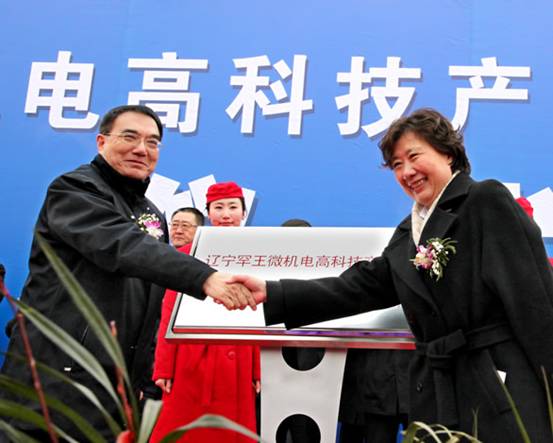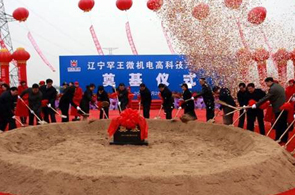關(guān)鍵字:罕王集團(tuán) MEMS 晶圓廠
罕王集團(tuán)打算生產(chǎn)慣性傳感器和硅膜麥克風(fēng),這兩種產(chǎn)品在中國(guó)都有旺盛的需求。該公司也在討論生產(chǎn)胎壓傳感器和用于醫(yī)療應(yīng)用的微流體MEMS。中國(guó)目前生產(chǎn)的大量電子設(shè)備所使用的MEMS器件,幾乎全部需要進(jìn)口。由于沒(méi)有關(guān)稅和勞動(dòng)力成本較低,罕王MEMS器件的成本將低于進(jìn)口產(chǎn)品,因此應(yīng)該能夠在中國(guó)系統(tǒng)生產(chǎn)商中找到買家。
為了實(shí)現(xiàn)上述目標(biāo),罕王集團(tuán)成立了合資子公司Hanking Electronics Co. Ltd.,并聘請(qǐng)MEMS產(chǎn)業(yè)資深人士Doug Sparks擔(dān)任執(zhí)行副總裁幫助實(shí)施相關(guān)計(jì)劃。Sparks向總裁兼首席執(zhí)行官Lucy Huang報(bào)告。

晶圓廠2012年3月動(dòng)工興建,位于沈陽(yáng)以東40英里左右的撫順。Sparks表示,工廠將坐落在罕王MEMS工業(yè)園(HMIP)之中,道路已經(jīng)在2011年平整完畢。工業(yè)園位于撫順經(jīng)濟(jì)開(kāi)發(fā)區(qū),占地約160英畝。
罕王計(jì)劃投資30億元人民幣(約4.75億美元),分三個(gè)階段進(jìn)行開(kāi)發(fā)。Sparks表示,盡管初期準(zhǔn)備安裝200毫米晶圓生產(chǎn)設(shè)備,但廠房是為滿足“300毫米晶圓生產(chǎn)”建造的。他預(yù)測(cè),將在幾年內(nèi)向生產(chǎn)300毫米MEMS晶圓過(guò)渡,目前MEMS領(lǐng)域還沒(méi)有一家廠商能夠生產(chǎn)300毫米晶圓。
Sparks表示,MEMS晶圓廠在第一階段,將能夠在2014年每月生產(chǎn)大約4000個(gè)200毫米初制晶圓。他說(shuō),“我們將在2013年以前擁有后端處理制程,比如電鍍與蝕刻,再過(guò)一年可能就會(huì)擁有一切制程。”
但Sparks并不十分擔(dān)心進(jìn)度拖延。他說(shuō),罕王進(jìn)入MEMS領(lǐng)域是一項(xiàng)長(zhǎng)期計(jì)劃,而且資金充足。中國(guó)罕王控股有限公司是罕王集團(tuán)的附屬企業(yè)之一,2011年9月在香港上市,2011年凈利潤(rùn)為6.706億元人民幣,營(yíng)業(yè)收入為14.5億元人民幣(約合2.3億美元)。Sparks表示,整個(gè)集團(tuán)的年?duì)I業(yè)收入約為5.5億美元。

先代工,再采取IDM模式,同時(shí)引進(jìn)MUMPS?
Sparks表示,罕王希望最終成為MEMS IDM廠商,生產(chǎn)自有品牌的元件,不過(guò)屆時(shí)可能有70%的自有品牌業(yè)務(wù)和30%的代工業(yè)務(wù)。但是,在實(shí)現(xiàn)那一步之前,罕王最初可能需要向主要MEMS廠商提供代工服務(wù)。
Sparks表示,他一直在考慮與MEMS IDM廠商和代工廠商合作。如果能夠成為一家MEMS廠商的中國(guó)代工者,罕王就可以安裝“一模一樣”的設(shè)備,在為其生產(chǎn)產(chǎn)品的同時(shí),也可以學(xué)到MEMS技術(shù)。Sparks表示,“我們一直在與幾家潛在的戰(zhàn)略伙伴談判,”但他拒絕透露具體的公司名稱。
Sparks表示,他也在與MEMS代工廠商Memscap SA (法國(guó)Bernin)接觸,準(zhǔn)備把MUMPS系統(tǒng)引入中國(guó)。MUMPS是標(biāo)準(zhǔn)化制程模組系統(tǒng),可以讓不同的客戶共享晶圓面積,類似于CMOS中的多項(xiàng)目晶圓(MPW)方式。
MUMPS代表Multi-User MEMS Processes(多用戶MEMS工藝),最初是1980年代在美國(guó)加州大學(xué)伯克利分校開(kāi)發(fā)的一個(gè)項(xiàng)目,后來(lái)轉(zhuǎn)到了美國(guó)北卡羅菜納微電子中心 (MCNC),并成為向研究人員提供MEMS流片服務(wù)的一個(gè)手段。該服務(wù)后來(lái)轉(zhuǎn)讓給了Cronos Integrated Microsystems Inc.,包括在北卡羅來(lái)納州三角研究園的一個(gè)晶圓廠。后來(lái)于2003年被Memscap收購(gòu)。Memscap利用該設(shè)施向客戶提供MEMS流片服務(wù),然后投入批量生產(chǎn)。
Sparks表示,如果能夠使用這樣的低成本系統(tǒng),中國(guó)許多小型公司可能對(duì)MEMS感興趣。罕王在美國(guó)克利夫蘭也設(shè)有辦事處。他說(shuō),“我們已開(kāi)始在那里進(jìn)行一些設(shè)計(jì)工作,以啟動(dòng)這個(gè)項(xiàng)目。”
Sparks還補(bǔ)充道,Hanking Electronics也考慮在無(wú)線傳感器網(wǎng)絡(luò)領(lǐng)域,并打算給中國(guó)的一些相關(guān)電子產(chǎn)品貼牌銷售,以此擴(kuò)大其銷售與市場(chǎng)基礎(chǔ)。
罕王并不是在中國(guó)建立MEMS工廠的第一家公司。1999年從模擬器件公司分拆出來(lái)的美國(guó)Memsic Inc.,在無(wú)錫建立了一家后端工廠,使用加工過(guò)的臺(tái)積電CMOS晶圓。
2011年10月接受Hanking Electronics的現(xiàn)有職務(wù)之前,Sparks曾在美國(guó)MEMS公司Integrated Sensing Systems Inc.工作過(guò)10年,再早在Delco從事汽車MEMS工作17年。Delco已更名為Delphi。
Sparks在Delphi期間,聘用了一名來(lái)自美國(guó)凱斯西儲(chǔ)大學(xué)(Case Western Reserve University)的中國(guó)碩士畢業(yè)生Lucy Huang,即Hanking Electronics的現(xiàn)任總裁兼首席執(zhí)行官。
Hanking starts building Chinese MEMS wafer fab
Peter Clarke
Hanking Group (Shenyang, China), a mining and metal processing conglomerate in the north-east of China, has begun building what could become a major wafer fab for the manufacture of microelectromechanical systems (MEMS).
Hanking is looking to make inertial sensors and silicon membrane microphones which are all in high demand in China, but has also talked about tire pressure monitor sensors and microfluidic MEMS for medical applications. China currently imports almost all the MEMS devices used in the high volumes of electronic equipment made in the country. The company should be able to find ready buyers at Chinese system makers for the components which would be lower cost than imported MEMS due to an absence of duties and lower labor costs.
The group has created a wholly-owned subsidiary, Hanking Electronics Co. Ltd., as the means to achieve its goal and recruited MEMS industry veteran Doug Sparks as executive vice president to help execute the plan. Sparks reports to Lucy Huang, president and CEO.
Construction of the wafer fab started in March 2012 in Fushun about 40 miles east of Shenyang. The buildings will sit in the Hanking MEMS Industrial Park (HMIP) which occupies about 160 acres in Fushun Economic Development Zone and for which the roads were laid out during the 2011 construction season, Sparks said.
Hanking has committed to spend 3 billion yuan (about $475 million) on three phases of development there. Although Sparks is looking to install 200-mm equipment initially, the building is being made "compatible with 300-mm wafer production," he said. The transition to 300-mm wafer processing for MEMS, something not yet done by any manufacturers in the MEMS sector, would come in a few years, Sparks predicted.
The first phase of the MEMS wafer fab will be capable of producing about 4,000 200-mm wafer starts per month in 2014, Sparks said. "We'll have the back-end processing – things like electroplating and bulk etch going by 2013 – It may be another year before we have everything running," he said.
But Sparks is not too concerned about delays. Hanking is into MEMS for the long haul and has money to spend, he said. China Hanking Holdings Ltd., one of the affiliates of the Hanking Group, was admitted to the Hong Kong stock exchange in September 2011 and declared a net profit of 670.6 million yuan (about $106 million) on sales revenue of 1.45 billion yuan (about $230 million) for 2011. However, Sparks said total group annual revenue is about $550 million.
Foundry first, then IDM, meanwhile MUMPS?
Ultimately Hanking wants to be a MEMS IDM making components under its own badge, although it may then run a mix of 70 percent own-brand and 30 percent foundry wafers, Sparks said. However, before it can do that it will likely need to start by offering foundry services to eastablished MEMS manufacturers.
Sparks said that he has been looking at partnerships with MEMS IDMs and foundries. A contract to be a China-based manufacturer on behalf of a MEMS maker would let Hanking install a "copy-exact" equipment line and begin to learn its MEMS skills while making product for someone else. "We've been talking to a couple of potential strategic partners," said Sparks but he declined to reveal names.
Sparks said that he was also talking to MEMS foundry Memscap SA (Bernin, France) about bringing the MUMPS system to China. MUMPS is a system of standardized process modules that enables the sharing of wafer area by multiple customers, similar to multiproject wafer (MPW) runs in CMOS.
MUMPS stands for Multi-User MEMS Processes. It is a program that was originally developed at the University of California Berkeley in the 1980s before moving to Microelectronics Corporation of North Carolina (MCNC) and brought up as a means of providing academics with access to MEMS prototyping. The service was transferred to Cronos Integrated Microsystems Inc. including a wafer fab in Research Triangle Park, North Carolina, which was then acquired by Memscap in 2003. Memscap uses the facility to provide customers with access to MEMS prototyping and then transition to volume manufacturing.
Sparks said that a lot of small companies in Chinese could be interested in MEMS if they could access such a low-cost access system. Hanking also has offices in Cleveland, Ohio. "We've started doing some designs there to get things off the ground," said Sparks.
Sparks added that Hanking Electronics is also looking to re-label and some electronic products in China in the area of wireless sensor networks as a means of building up its sales and marketing infrastructure.
Hanking is not the first company to build a MEMS fab in China. Memsic Inc. (Andover, Mass.), a 1999 spin-off from Analog Devices Inc. constructed a back-end fab in Wuxi that worked with processed CMOS wafers from Taiwan Semiconductor Manufacturing Co. Ltd.
Before taking up his current position with Hanking Electronics in October 2011, Sparks had worked with MEMS company Integrated Sensing Systems Inc. (Ypsilanti, Michigan) for ten years and prior to that had worked on automotive MEMS for 17 years at Delco which became Delphi.
It was while Sparks was at Delphi that he hired a Chinese MSc. graduate from Case Western Reserve University (Cleveland, Ohio), Lucy Huang, who subsequently landed the top job at Hanking Electronics.
 移動(dòng)設(shè)備訪問(wèn)
移動(dòng)設(shè)備訪問(wèn)